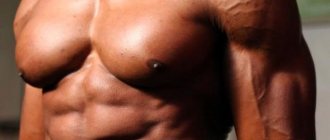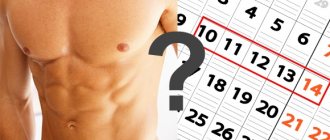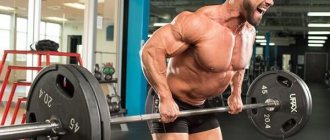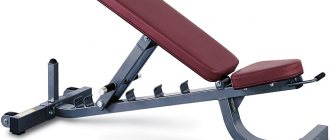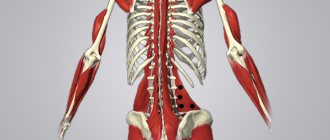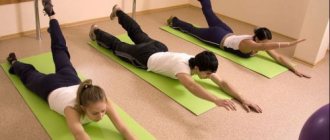Exercises to tighten and enlarge the pectoral muscles eliminate excess fat and create a sculpted upper torso.
To achieve results, it is necessary to correctly calculate the level of target load during exercise with dumbbells and barbells, combining them with working out the muscle corset, shoulders and arms.
Cardio training, breathing exercises and a healthy diet are necessary conditions for effective body shaping.
Anatomy of the pectoral muscles
The pectoralis major muscle is located in a fan shape on both sides of the sternum and occupies 90% of the entire surface of this area.
In the upper part, the flat muscle fibers are adjacent to the deltoid, and from the bottom - to the subscapularis muscle of the back.
The large muscle is used when moving the arms from top to bottom and horizontal turns towards the body, for example, when crossing the arms in front of oneself.
Invisible on the surface of the body, the pectoralis minor muscle consists of narrow parallel fibers that are adjacent to the 3rd, 4th and 5th ribs and the scapula. It stabilizes the scapula and provides rotational movements.
Under the pectoralis major there is also the serratus anterior muscle, the fibers of which rise in a sawtooth pattern along the outer surface of the ribs to the lower edge of the scapula.
Anatomy of the chest muscles
The pectorals are one of the three largest muscle groups. They are located above the abdominals.
The main muscles can be identified:
- Pectoralis major muscle . This is the largest muscle of this group. It is on its development that we will spend 90% of our efforts. Conventionally, it is divided into three zones: upper (least developed and weakest), middle (largest zone, which gives volume to the breasts), lower (anatomically the strongest).
- Small chest. Located under the pectoralis major muscle. Its development will help increase breast size, making it more massive.
Their function is to bring the arm to the body. That is, if we spread our arms to the sides, then in order to bring them together in front of us we will connect the pectoral muscles.
And there are also secondary muscles, but this does not mean that they are less important than the main ones:
- Serratus anterior muscles. They help the rhomboids bring the shoulder blades together, thereby stretching the pectoralis major muscles more.
- Subclavius muscle. Responsible for the movement of the collarbone.
Good development of this muscle group increases the volume of the chest. Such a change will visually affect the breasts themselves, visually making them larger.
If you want to learn more about the chest muscles, I advise you to read my article "
Anatomy of the pectoral muscles."
Important note from coaches
Overdoing exercises to increase the pectoralis major muscle, to the detriment of working out the back and arms, can lead to a change in posture that is not for the better.
This area can be pumped up relatively quickly with simple movements, but the stiffer the muscle becomes, the greater the likelihood of stooping, displacement of the shoulder blades and protrusion of the neck forward.
An overactive sternum muscle takes over the function of neighboring groups, causing them to weaken.
Cross syndrome with uneven pumping leads to pain and limited movement. Therefore, the effect on the zone must be supplemented with stretching and posture correction, working all neighboring muscle groups in parallel and with equal intensity.
Stretching complex
Stretching - stretching eliminates tension, relieves pain, stimulates blood circulation. Performed independently, in between or after exercises to strengthen the pectoral muscles.
Stand facing the corner of the room, rest your palms on the walls, elbows at the level of the shoulder joint, feet shoulder-width apart.
From this position, 7-8 slow rocking movements are made forward with a straight back, without bending the back. Then the arms are raised along the wall so that the elbows are at eye level, and another set is performed.
Sit on the floor with your feet crossed, arms straight at the floor behind your back. Springy movements of the chest up and forward - 30 seconds, delay at the extreme point - 10 seconds.
Push-ups for working the torso
Raising and lowering a horizontal body with support on your hands is one of the basic exercises for strengthening the pectoral muscles.
Mastering the technique of execution is much more important than the number of repetitions; special attention requires maintaining a straight line of the body, which can be trained by performing the plank.
You can start with lightweight push-up options - the starting position is from your knees or with a hand support raised from the floor.
The minimum number of repetitions is 3, gradually increasing to 12, progress varies with increasing number of sets.
You can apply the following scheme for weeks of training: 2 by 3, 2 by 5, 3 by 5, 2 by 10, 3 by 10. Performing 4 sets with 10-12 repetitions gives the full effect.
It is recommended to alternate the pace of execution, making quick downward movements with slow upward movements, and vice versa.
The following complicated modifications of the standard push-up distribute the load to different zones:
- push-ups with feet fixed on a stand 50-60 cm high;
- alternately transferring weight to one hand;
- push-ups with arms spread wide;
- push-ups with hands narrower than shoulder width;
- push-ups with weights on the back or an expander held behind the back with the ends secured under the palms.
Dumbbell Curl
Arm curls are one of the simplest exercises for tightening your breasts. It affects the chest muscles, making them strong and voluminous.
- Stand up straight, leaning slightly forward, and hold a dumbbell in each hand.
- Bend your elbows 90 degrees.
- Elbows should be pressed to the body.
- Hold the dumbbells for a few seconds and then return to the starting position.
- Do 15 times.
Complex with dumbbells
The best sports equipment for exercising the pectoral muscles is dumbbells. To remove fat deposits, 1.5-2 kg of load on each side is enough, the goal of increasing volume is achieved with 5 kilograms.
In this case, you need to start with dumbbells, which allow you to perform 5-7 repetitions without tension.
The arm raise is a basic movement involving the chest muscles, performed while lying on your back, helping to concentrate the load.
The starting position on a bench is considered more effective, since the free space on the sides increases the amplitude of movement, promoting a comprehensive workout of the arms, shoulders and neck.
Three main exercises:
- Stretch your arms straight in front of you, perpendicular to the floor, then, as you exhale, spread them, bending your elbows at 90 degrees, and as you exhale, press the weight forward.
- From the same position, swing your arms straight, then bring them together in front of you.
- Place your arms straight above your head on your hips, making a semicircle.
When performing movements with dumbbells, you need to relax your shoulders, hands and elbows as much as possible and focus on working the thoracic region.
The best exercises for the pectoral muscles
So let's finally get to our list of the 10 best chest exercises at the gym, listed in no particular order. In it you will find basic exercises for the pectoral muscles, as well as isolation exercises, depending on your training goals.
Bench press
Reason for inclusion in the list
This chest exercise is good for working the middle and lower part of the pectoral muscles, but requires proper technique.
You can generate maximum force by performing different barbell exercises, so the standard bench press allows you to lift the most weight. In addition, this chest exercise allows you to balance the weight better than an exercise with heavy dumbbells. The bench press is easy to belay and relatively simple to master. There are many variations of this chest exercise that you can use to increase strength and mass.
BENCH PRESS
Place in the training program
Perform bench presses at the beginning of your chest workout, using heavy weights but limiting your reps to low reps. Try different grip widths for a more detailed workout of the pectoral muscles.
Dumbbell bench press
A great exercise to tone all parts of your chest muscles. It involves the upper, middle and lower thoracic regions.
Reason for inclusion in the list
Chest exercises with dumbbells allow each part of the body to move independently of the other, this engages the stabilizer muscles. The dumbbell press requires additional effort to balance them, as it is necessary to constantly maintain the correct trajectory. Dumbbells also provide the opportunity to increase the range of motion compared to the barbell press, both in the lower and upper phases of the exercise. The dumbbell bench press will allow you to lift quite a lot of weight, and can also be a good alternative to the long-practised bench press.
DUMBBELL PRESS ON A HORIZONTAL BENCH
Place in the training program
Perform flat dumbbell presses to begin your chest workout, using heavy weights for low reps. We generally don't recommend this exercise in addition to the bench press because the exercises are so similar.
Their identity was confirmed through electromyography (EMG), which revealed no significant differences between them in terms of muscle activation.
Bench press at an upward angle
Reason for inclusion in the list
The main working muscles are the upper chest.
Often the bench is placed at a very steep angle, thereby forcing the front deltoids, rather than the pectoral muscles, to be involved in the work. Therefore, if you want to focus on developing the upper chest and not overload the deltoids, use a less steep incline of the bench. You can also do this easily with an adjustable bench on a Smith machine.
EMG results showed that a narrow grip allows for significantly better work of the upper pectoral muscles.
BAR PRESS AT AN ANGLE
Place in the training program
Often, chest workouts at the gym start with bench presses and later move on to incline presses, but it's time to break this bad habit. Start practicing incline presses from time to time. The advantage will be that you will be able to handle more weight and, as a result, better work the upper pectoral muscles.
Hummer chest press
Reason for inclusion in the list
Some machines (for example) allow you to work each arm separately, independently of each other, which is a great advantage for chest training. In addition to the usual position, in such machines you can sit sideways and perform a bench press with one arm across your body. This will give a completely different load than what would be in the standard position.
With such a transverse movement, the pectoralis major muscle comes into play. Think back to the butterfly or crossover exercise to get an idea of the exercise. Sitting in this position, you maximally load the pectoral muscles, which means you enhance the effect of the exercise.
HAMMER CHEST PRESS
Place in the training program
Perform free weight chest exercises early in your workout because they require more balance and alignment than machine exercises. Therefore, the cross press in the machine is suitable as the last multi-joint exercise in your training program.
Exercises with an expander
Elastic expanders and sports bands allow you to perform exercises on the pectoral muscles at home:
- Expander in front, hands at shoulder level, make spreading movements to the sides.
- Move the expander behind your back at the level of the shoulder blades and the back plane of your arms, with an effort while exhaling, connect their ends in front of you, then spread them apart.
- From a standing or lying position on your back, pass the rubber through the back, bring it out at the level of your armpits and do presses forward.
How to pump up your chest muscles?
There are many exercises as well as attributes as discussed earlier.
Unfortunately, you won’t be able to pump up such muscle mass with a simple warm-up. To get delts, you'll need to do really hard, high-impact workouts.
The pectoral muscles are pumped mainly by three attributes:
- dumbbells;
- barbell;
- on uneven bars.
Almost everyone knows how to properly pump the chest with dumbbells. Swing the dumbbells in different directions, gradually increasing the load.
As a rule, at home this is quite enough to maintain a beautiful appearance of your breasts. Take two dumbbells, lift them to shoulder level, lower them down, repeat the procedure, moving the dumbbells in different directions.
Be sure to perform the exercise several times, then rest for fifteen seconds and repeat again. After a few workouts, the dumbbells will not seem so heavy to you, so gradually increase the load.
The dumbbell press can also be done while lying down, so you can place the load directly on your chest. Do 4 sets of 10 reps if you are a beginner.
Exercises with a barbell are the best way to pump up not only your chest, but also your arms and other muscles.
We can answer the question of how to properly pump your chest with a barbell, but what weight to lift, as well as the frequency of training, depends on your level of training and body weight.
Select weights that you can lift, lie down on a bench and lift the barbell up. The standard option for beginners is the bench press – 4 sets of 10 reps.
Increase the load as much as possible, train more often, do more approaches.
Dips are performed to pump the lower part of the pectoral muscles. Do several approaches; for beginners, 5 repetitions and three sets are enough.
When lowering down, it is important that the process is performed slowly, and the body should feel light and weightless.
Lower yourself smoothly - it’s better to do less exercises, but high-quality ones.
How to properly pump your chest on parallel bars - there are no serious requirements here; you can include this kind of push-ups in simple daily workouts for 15 minutes.
Crossover for sculpted breasts
Training in the gym on the pectoral muscles using a crossover - block exercise machine allows you to perform isolating exercises to correct individual areas of the sternum.
By adjusting the tension and different levels of the handles, you can change the angle of the shocks, targeting problem areas.
Consultation and coaching patronage will allow you to determine an individual training schedule and master the technique.
Particularly important is the correct starting position - the rack from which power pulls are performed.
Complex for women
The combination of various techniques in one complex helps to improve the shape of a woman’s breasts and strengthen the muscle corset necessary for a slim figure.
Exercises for the pectoral muscles for women begin with stretching. For the starting position, you need to take a straight stance against the wall, with the back of your head, shoulder blades, buttocks and feet in one line.
Then you need to take 2-3 steps forward, raise and move your arms bent at the elbows at right angles to the sides so that your forearms are parallel to your face.
Move your elbows back and squeeze your shoulder blades together, stretching the pectoral muscle. Hold the position at the extreme point for 20-30 seconds.
Camel pose (ustrasana) is performed with a backward bend from a kneeling position, in which you need to clasp your heels with the palms of your straightened arms.
The movement is performed by tensing the muscles of the legs and buttocks, keeping the hips at right angles to the floor. Stretching should be done up to 2 sets with 5 repetitions.
The next part of the workout is dumbbell exercises or push-ups, which should be performed in 2 sets of 10 repetitions, from a bench or lying on a sports ball.
You can include isometric exercises for tightening in your workout:
- Squeeze your palms together in a prayer position;
- Place your hands on your waist - move your elbows back as far as possible;
- Place your palms against the wall and imitate pushing forward;
- Turning your back to the wall, lower your arms and press your palms into the wall.
At the point of extreme tension you need to hold for 15-20 seconds and perform each exercise 5-8 times.
How to pump up your pectoral muscles
Exercises for men aimed at symmetrically increasing the volume of the pectoral muscles are combined with equal loads on the arms, shoulders and back.
Strength training for relief, in addition to training with dumbbells, includes bench press in front of you from a lying position, dips, exercises on the butterfly machine, and individually selected movements on the crossover.
At home, you can pump up your muscles by mastering various types of push-ups from the floor, and combining them with multidirectional loads when swinging your arms, weighted with dumbbells.
Strength training is carried out 2 to 3 times a week, with a minimum break every other day.
In one lesson, you can vary 4-5 different exercises, performing 4 approaches with 10 repetitions.
How to pump up your chest correctly for a beginner
Beginners often worry about whether they will be able to get the desired result if they really do it all. In addition, there is laziness and a desire to somehow simplify classes.
In fact, you need to set yourself up and at least start doing exercises; the desire to play sports will appear as soon as you see the first fruits of your training.
Beginners are recommended to do more approaches, but with less load. This way, you can quickly get used to the exercises, and then gradually increasing the load, you can calmly get into the rut.
Don’t forget about a healthy diet, which should be planned down to the smallest detail, give up tasty treats, and focus on protein foods.
Combine a healthy diet with training, you can quickly gain muscle mass, and thanks to constant exercise, the protein entering your body will quickly be distributed between the muscles that you are currently working.
You can take into account world athletes to motivate yourself to pump up your chest. Go to master classes, since pumping up the pectoral muscles is not so easy.
The best representative of his occupation is Arnold Schwarzenegger. A video with Schwarzenegger will tell you how to properly pump up your chest; the famous champion made a significant contribution to the sport and shared his success with a beginner.
Work out with a trainer or spend enough time practicing at home, don’t lose your spirit and strive for better results. Without a doubt, you will succeed!

